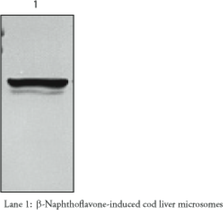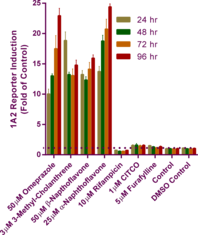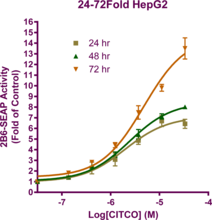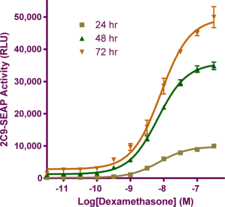Cayman
Showing 16801–16950 of 45550 results
-
Cyclosporin C is a fungal metabolite that has been found in T. inflatum and has diverse biological activities, including antifungal, antiviral, and immunosuppressant properties.{24990,53111,53112,53113} It is active against isolates of B. cinerea, A. niger, and Alternaria, Mucor, and Penicillium species (MICs = 0.1-5 μg/ml).{53111} Cyclosporin C (15 μg/ml) inhibits vaccinia virus replication in infected BSC40 cells by 98.82%.{53112} It inhibits lymphocyte proliferation induced by the mitogens concanavalin A (ConA; Item No. 14951), phytohemagglutinin L (PHA), and pokeweed mitogen (PWM), as well as proliferation induced by alloantigen in mixed lymphocyte culture when used at a concentration of 100 ng/ml.{53113} Cyclosporin C (100 ng/ml) inhibits the local graft versus host (GVH) reaction in mice receiving splenocyte grafts.
Brand:CaymanSKU:29152 - 5 mgAvailable on backorder
Cyclosporin D is a metabolite of cyclosporin A, an immunosuppressant drug that binds cyclophilin D, inhibiting the phosphatase activity of calcineurin in T cells.{24989,24993} Cyclosporin D displays about 10% lower immunosuppressant activity than cyclosporin A.{24990,24991} Cyclosporin D has been used as an internal standard for the quantification of cyclosporin A.{24992}
Brand:CaymanSKU:-Cyclosporin D is a metabolite of cyclosporin A, an immunosuppressant drug that binds cyclophilin D, inhibiting the phosphatase activity of calcineurin in T cells.{24989,24993} Cyclosporin D displays about 10% lower immunosuppressant activity than cyclosporin A.{24990,24991} Cyclosporin D has been used as an internal standard for the quantification of cyclosporin A.{24992}
Brand:CaymanSKU:-Cyclosporin H is a natural cyclic undecapeptide that selectively antagonizes the formyl peptide receptor at concentrations ranging from 0.1 to 10 µM.{28067,28068,28069} Unlike cyclosporin A (Item No. 12088), cyclosporin H does not bind cyclophilin to evoke an immunosuppressant response.{28070} Cyclosporin H has been reported to inhibit phorbol ester-mediated effects in mouse skin and block calcium/calmodulin-dependent EF-2 phosphorylation in vitro.{28071}
Brand:CaymanSKU:-Out of stock
Cyclosporin H is a natural cyclic undecapeptide that selectively antagonizes the formyl peptide receptor at concentrations ranging from 0.1 to 10 µM.{28067,28068,28069} Unlike cyclosporin A (Item No. 12088), cyclosporin H does not bind cyclophilin to evoke an immunosuppressant response.{28070} Cyclosporin H has been reported to inhibit phorbol ester-mediated effects in mouse skin and block calcium/calmodulin-dependent EF-2 phosphorylation in vitro.{28071}
Brand:CaymanSKU:-Out of stock
Receptors for AMPA are ionotropic glutamate receptors with critical roles in neurological development and function.{23037,21634,14541} Cyclothiazide is a benzothiadiazide that acts as a potentiator of AMPA receptors, positively modulating its response to glutamic acid (EC50 = 3.8 µM).{26686,26685,24138} It blocks the rapid agonist-induced desensitization of AMPA receptors, resulting in enhanced excitatory activity.{24138} Cyclothiazide is also a negative modulator of GABAA receptors, reversibly inhibiting both evoked and spontaneous inhibitory postsynaptic currents (IC50 = 58 µM).{26693,26687}
Brand:CaymanSKU:-Out of stock
Receptors for AMPA are ionotropic glutamate receptors with critical roles in neurological development and function.{23037,21634,14541} Cyclothiazide is a benzothiadiazide that acts as a potentiator of AMPA receptors, positively modulating its response to glutamic acid (EC50 = 3.8 µM).{26686,26685,24138} It blocks the rapid agonist-induced desensitization of AMPA receptors, resulting in enhanced excitatory activity.{24138} Cyclothiazide is also a negative modulator of GABAA receptors, reversibly inhibiting both evoked and spontaneous inhibitory postsynaptic currents (IC50 = 58 µM).{26693,26687}
Brand:CaymanSKU:-Out of stock
Receptors for AMPA are ionotropic glutamate receptors with critical roles in neurological development and function.{23037,21634,14541} Cyclothiazide is a benzothiadiazide that acts as a potentiator of AMPA receptors, positively modulating its response to glutamic acid (EC50 = 3.8 µM).{26686,26685,24138} It blocks the rapid agonist-induced desensitization of AMPA receptors, resulting in enhanced excitatory activity.{24138} Cyclothiazide is also a negative modulator of GABAA receptors, reversibly inhibiting both evoked and spontaneous inhibitory postsynaptic currents (IC50 = 58 µM).{26693,26687}
Brand:CaymanSKU:-Out of stock
Receptors for AMPA are ionotropic glutamate receptors with critical roles in neurological development and function.{23037,21634,14541} Cyclothiazide is a benzothiadiazide that acts as a potentiator of AMPA receptors, positively modulating its response to glutamic acid (EC50 = 3.8 µM).{26686,26685,24138} It blocks the rapid agonist-induced desensitization of AMPA receptors, resulting in enhanced excitatory activity.{24138} Cyclothiazide is also a negative modulator of GABAA receptors, reversibly inhibiting both evoked and spontaneous inhibitory postsynaptic currents (IC50 = 58 µM).{26693,26687}
Brand:CaymanSKU:-Out of stock
Cyclovirobuxine D (CVB-D) is an alkaloid, and the main active component of the traditional Chinese medicine B. microphylla, that has diverse biological activities.{41280,41281,41282,41283,41284,41285} It is an ether-a-go-go related gene (ERG) potassium channel blocker with an IC50 value of 19.7 μM using whole-cell patch-clamp electrophysiology in HEK293 cells expressing the human receptor.{41280} IERG blockade is activation-dependent, indicating CVB-D binds to open ERG channels. CVB-D increases the amount and rate of calcium release from intracellular stores in healthy neonatal rat cardiac myocytes and those isolated from adult rats with heart failure in a concentration-dependent manner.{41281} It also increases expression of ryanodine receptor 2 (Ryr2) and sarcoplasmic reticulum calcium ATPase 2a (Serca2a) and decreases expression of the sodium-calcium exchanger (Ncx). In vivo, CVB-D (0.5-2.0 mg/kg) reduces mortality and improves cardiac function in a rat model of congestive heart failure.{41282} CVB-D pretreatment (1 mg/kg per day for 4 days) inhibits myocardial apoptosis and mitochondrial cytochrome C release induced by doxorubicin (Item No. 15007) in mice.{41283} CVB-D also induces cellular autophagy and inhibits growth of MCF-7 breast cancer cells and induces mitochondrial apoptosis in MGC803 and MKN26 gastric cancer cells.{41284,41285}
Brand:CaymanSKU:22260 -Out of stock
Cyclovirobuxine D (CVB-D) is an alkaloid, and the main active component of the traditional Chinese medicine B. microphylla, that has diverse biological activities.{41280,41281,41282,41283,41284,41285} It is an ether-a-go-go related gene (ERG) potassium channel blocker with an IC50 value of 19.7 μM using whole-cell patch-clamp electrophysiology in HEK293 cells expressing the human receptor.{41280} IERG blockade is activation-dependent, indicating CVB-D binds to open ERG channels. CVB-D increases the amount and rate of calcium release from intracellular stores in healthy neonatal rat cardiac myocytes and those isolated from adult rats with heart failure in a concentration-dependent manner.{41281} It also increases expression of ryanodine receptor 2 (Ryr2) and sarcoplasmic reticulum calcium ATPase 2a (Serca2a) and decreases expression of the sodium-calcium exchanger (Ncx). In vivo, CVB-D (0.5-2.0 mg/kg) reduces mortality and improves cardiac function in a rat model of congestive heart failure.{41282} CVB-D pretreatment (1 mg/kg per day for 4 days) inhibits myocardial apoptosis and mitochondrial cytochrome C release induced by doxorubicin (Item No. 15007) in mice.{41283} CVB-D also induces cellular autophagy and inhibits growth of MCF-7 breast cancer cells and induces mitochondrial apoptosis in MGC803 and MKN26 gastric cancer cells.{41284,41285}
Brand:CaymanSKU:22260 -Out of stock
Cyclovirobuxine D (CVB-D) is an alkaloid, and the main active component of the traditional Chinese medicine B. microphylla, that has diverse biological activities.{41280,41281,41282,41283,41284,41285} It is an ether-a-go-go related gene (ERG) potassium channel blocker with an IC50 value of 19.7 μM using whole-cell patch-clamp electrophysiology in HEK293 cells expressing the human receptor.{41280} IERG blockade is activation-dependent, indicating CVB-D binds to open ERG channels. CVB-D increases the amount and rate of calcium release from intracellular stores in healthy neonatal rat cardiac myocytes and those isolated from adult rats with heart failure in a concentration-dependent manner.{41281} It also increases expression of ryanodine receptor 2 (Ryr2) and sarcoplasmic reticulum calcium ATPase 2a (Serca2a) and decreases expression of the sodium-calcium exchanger (Ncx). In vivo, CVB-D (0.5-2.0 mg/kg) reduces mortality and improves cardiac function in a rat model of congestive heart failure.{41282} CVB-D pretreatment (1 mg/kg per day for 4 days) inhibits myocardial apoptosis and mitochondrial cytochrome C release induced by doxorubicin (Item No. 15007) in mice.{41283} CVB-D also induces cellular autophagy and inhibits growth of MCF-7 breast cancer cells and induces mitochondrial apoptosis in MGC803 and MKN26 gastric cancer cells.{41284,41285}
Brand:CaymanSKU:22260 -Out of stock
Cyfluthrin is a pyrethroid insecticide and a modulator of voltage-gated sodium channels (Nav).{36375,41867} It slowly activates rat recombinant Nav1.8 channels, delays inactivation by longer than 40 ms, and induces persistent tail currents in channels expressed in X. laevis oocytes.{36375} It also decreases the mean burst rate in rat primary neurons (IC50 = 0.99 μM, respectively).{41867} Cyfluthrin is toxic to various insects, including A. melinus, G. ashmeadi, E. eremicus, and E. formosa (LC50s = 7, 67, 96, and 63 ng/ml, respectively) and the A. sinensis mosquito (LC50 = 0.446 ppm).{41868,41869} It is also toxic to A. mellifera honeybees (LD50 = 0.22 ppm), affecting locomotor activity and wing fanning behavior with an increase in the mean bout duration of time spent upside down, indicating disruption of the righting reflex, and a decrease in wing fanning behavior when administered at a dose of 10 ng/bee.{41870} Formulations containing cyfluthrin have been used for the control of insects in agriculture and for non-commercial purposes.
Brand:CaymanSKU:24231 - 100 mgAvailable on backorder
Cylindrospermopsin, a tricyclic uracil derivative, is a cyanobacterial toxin that was first discovered in an algal bloom contaminating a local drinking supply on Palm Island in Queensland, Australia after an outbreak of a mysterious disease. Cylindrospermopsin targets protein and glutathione synthesis in hepatocytes (IC50s = 1.3 and 2.4 µM, respectively), leading to cell death.{14283} It has been shown to inhibit the activity of the uridine monophosphate synthase complex with a Ki value of 10 µM.{14282} Cylindrospermopsin is genotoxic, inducing DNA damage as evidenced by double strand breaks and reducing cell viability in HepG2 cells at 0.1-0.5 µg/ml.{26087}
Brand:CaymanSKU:10007867 - 100 µgAvailable on backorder
Cylindrospermopsin, a tricyclic uracil derivative, is a cyanobacterial toxin that was first discovered in an algal bloom contaminating a local drinking supply on Palm Island in Queensland, Australia after an outbreak of a mysterious disease. Cylindrospermopsin targets protein and glutathione synthesis in hepatocytes (IC50s = 1.3 and 2.4 µM, respectively), leading to cell death.{14283} It has been shown to inhibit the activity of the uridine monophosphate synthase complex with a Ki value of 10 µM.{14282} Cylindrospermopsin is genotoxic, inducing DNA damage as evidenced by double strand breaks and reducing cell viability in HepG2 cells at 0.1-0.5 µg/ml.{26087}
Brand:CaymanSKU:10007867 - 25 µgAvailable on backorder
Cylindrospermopsin, a tricyclic uracil derivative, is a cyanobacterial toxin that was first discovered in an algal bloom contaminating a local drinking supply on Palm Island in Queensland, Australia after an outbreak of a mysterious disease. Cylindrospermopsin targets protein and glutathione synthesis in hepatocytes (IC50s = 1.3 and 2.4 µM, respectively), leading to cell death.{14283} It has been shown to inhibit the activity of the uridine monophosphate synthase complex with a Ki value of 10 µM.{14282} Cylindrospermopsin is genotoxic, inducing DNA damage as evidenced by double strand breaks and reducing cell viability in HepG2 cells at 0.1-0.5 µg/ml.{26087}
Brand:CaymanSKU:10007867 - 50 µgAvailable on backorder
Cylindrospermopsin, a tricyclic uracil derivative, is a cyanobacterial toxin that was first discovered in an algal bloom contaminating a local drinking supply on Palm Island in Queensland, Australia after an outbreak of a mysterious disease. Cylindrospermopsin targets protein and glutathione synthesis in hepatocytes (IC50s = 1.3 and 2.4 µM, respectively), leading to cell death.{14283} It has been shown to inhibit the activity of the uridine monophosphate synthase complex with a Ki value of 10 µM.{14282} Cylindrospermopsin is genotoxic, inducing DNA damage as evidenced by double strand breaks and reducing cell viability in HepG2 cells at 0.1-0.5 µg/ml.{26087}
Brand:CaymanSKU:10007867 - 500 µgAvailable on backorder
Sphingosine-1-phosphate (S1P) is an extracellular lipid mediator whose major effects are mediated through five distinct G protein-coupled receptors S1P1/EDG-1, S1P2/EDG-5, S1P3/EDG-3, S1P4/EDG-6, and S1P5/EDG-8. S1P4 couples to Gαi, Gαo, and Gα12/13 proteins leading to the stimulation of MAPK/ERK signaling pathways, as well as to PLC and Rho-Cdc42 activation, and is thought to contribute to immune responses. CYM 50308 is a novel agonist of SIP4 (EC50 = 56 nM) that displays 37-fold selectivity against S1P5 (EC50 = 2.1 μM) and no appreciable activity over the S1P1-3 subtypes at concentrations up to 25 μM.{24566}
Brand:CaymanSKU:-Sphingosine-1-phosphate (S1P) is an extracellular lipid mediator whose major effects are mediated through five distinct G protein-coupled receptors S1P1/EDG-1, S1P2/EDG-5, S1P3/EDG-3, S1P4/EDG-6, and S1P5/EDG-8. S1P4 couples to Gαi, Gαo, and Gα12/13 proteins leading to the stimulation of MAPK/ERK signaling pathways, as well as to PLC and Rho-Cdc42 activation, and is thought to contribute to immune responses. CYM 50308 is a novel agonist of SIP4 (EC50 = 56 nM) that displays 37-fold selectivity against S1P5 (EC50 = 2.1 μM) and no appreciable activity over the S1P1-3 subtypes at concentrations up to 25 μM.{24566}
Brand:CaymanSKU:-Sphingosine-1-phosphate (S1P) is an extracellular lipid mediator whose major effects are mediated through five distinct G protein-coupled receptors S1P1/EDG-1, S1P2/EDG-5, S1P3/EDG-3, S1P4/EDG-6, and S1P5/EDG-8. S1P4 couples to Gαi, Gαo, and Gα12/13 proteins leading to the stimulation of MAPK/ERK signaling pathways, as well as to PLC and Rho-Cdc42 activation, and is thought to contribute to immune responses. CYM 50308 is a novel agonist of SIP4 (EC50 = 56 nM) that displays 37-fold selectivity against S1P5 (EC50 = 2.1 μM) and no appreciable activity over the S1P1-3 subtypes at concentrations up to 25 μM.{24566}
Brand:CaymanSKU:-Sphingosine-1-phosphate (S1P) is an extracellular lipid mediator whose major effects are mediated through five distinct G protein-coupled receptors S1P1/EDG-1, S1P2/EDG-5, S1P3/EDG-3, S1P4/EDG-6, and S1P5/EDG-8. S1P4 couples to Gαi, Gαo, and Gα12/13 proteins leading to the stimulation of MAPK/ERK signaling pathways, as well as to PLC and Rho-Cdc42 activation, and is thought to contribute to immune responses. CYM 50308 is a novel agonist of SIP4 (EC50 = 56 nM) that displays 37-fold selectivity against S1P5 (EC50 = 2.1 μM) and no appreciable activity over the S1P1-3 subtypes at concentrations up to 25 μM.{24566}
Brand:CaymanSKU:-Sphingosine-1-phosphate (S1P) is an extracellular lipid mediator whose major effects are mediated through five distinct G protein-coupled receptors, S1P1/EDG-1, S1P2/EDG-5, S1P3/EDG-3, S1P4/EDG-6, and S1P5/EDG-8. S1P1 is important for vascular development and lymphocyte maturation, migration, and trafficking.{24542} CYM 5442 is a full agonist for S1P1 internalization, phosphorylation, and ubiquitination (EC50 = 1.35 nM).{28038} It is ineffective at S1P2, S1P3, S1P4, and S1P5 at concentrations up to 10 µM.{28038} CYM 5442 has been found to activate S1P1-mediated p42/p44 MAPK phosphorylation in CHO-K1 cells transfected with S1P1 with an EC50 value of 46 nM.{28038} At 50 nM, CYM 5442 can induce S1P1-dependent lymphopenia in mice, decreasing B and T cells by 65 and 85%, respectively.{28038}
Brand:CaymanSKU:-Out of stock
Sphingosine-1-phosphate (S1P) is an extracellular lipid mediator whose major effects are mediated through five distinct G protein-coupled receptors, S1P1/EDG-1, S1P2/EDG-5, S1P3/EDG-3, S1P4/EDG-6, and S1P5/EDG-8. S1P1 is important for vascular development and lymphocyte maturation, migration, and trafficking.{24542} CYM 5442 is a full agonist for S1P1 internalization, phosphorylation, and ubiquitination (EC50 = 1.35 nM).{28038} It is ineffective at S1P2, S1P3, S1P4, and S1P5 at concentrations up to 10 µM.{28038} CYM 5442 has been found to activate S1P1-mediated p42/p44 MAPK phosphorylation in CHO-K1 cells transfected with S1P1 with an EC50 value of 46 nM.{28038} At 50 nM, CYM 5442 can induce S1P1-dependent lymphopenia in mice, decreasing B and T cells by 65 and 85%, respectively.{28038}
Brand:CaymanSKU:-Out of stock
Sphingosine-1-phosphate (S1P) is an extracellular lipid mediator whose major effects are mediated through five distinct G protein-coupled receptors, S1P1/EDG-1, S1P2/EDG-5, S1P3/EDG-3, S1P4/EDG-6, and S1P5/EDG-8. S1P1 is important for vascular development and lymphocyte maturation, migration, and trafficking.{24542} CYM 5442 is a full agonist for S1P1 internalization, phosphorylation, and ubiquitination (EC50 = 1.35 nM).{28038} It is ineffective at S1P2, S1P3, S1P4, and S1P5 at concentrations up to 10 µM.{28038} CYM 5442 has been found to activate S1P1-mediated p42/p44 MAPK phosphorylation in CHO-K1 cells transfected with S1P1 with an EC50 value of 46 nM.{28038} At 50 nM, CYM 5442 can induce S1P1-dependent lymphopenia in mice, decreasing B and T cells by 65 and 85%, respectively.{28038}
Brand:CaymanSKU:-Out of stock
Sphingosine-1-phosphate (S1P) is an extracellular lipid mediator whose major effects are mediated through five distinct G protein-coupled receptors, S1P1/EDG-1, S1P2/EDG-5, S1P3/EDG-3, S1P4/EDG-6, and S1P5/EDG-8. S1P1 is important for vascular development and lymphocyte maturation, migration, and trafficking.{24542} CYM 5442 is a full agonist for S1P1 internalization, phosphorylation, and ubiquitination (EC50 = 1.35 nM).{28038} It is ineffective at S1P2, S1P3, S1P4, and S1P5 at concentrations up to 10 µM.{28038} CYM 5442 has been found to activate S1P1-mediated p42/p44 MAPK phosphorylation in CHO-K1 cells transfected with S1P1 with an EC50 value of 46 nM.{28038} At 50 nM, CYM 5442 can induce S1P1-dependent lymphopenia in mice, decreasing B and T cells by 65 and 85%, respectively.{28038}
Brand:CaymanSKU:-Out of stock
CYM 5478 is a sphingosine-1-phosphate receptor 2 (S1P2) agonist (EC50 = 0.78 μM in a reporter assay).{52124} It is selective for S1P2 over S1P1 and S1P3-5 in a TGFα-shedding assay (EC50s = 119, 1,690, 1,950, >10,000, and >10,000 nM, respectively). CYM 5478 (0.1-10 μM) reduces serum starvation-induced decreases in C6 rat glioma cell viability. It also reduces accumulation of reactive oxygen species (ROS) and apoptosis induced by cisplatin (Item No. 13119) in C6 cells when used at a concentration of 10 μM.
Brand:CaymanSKU:29024 - 1 mgAvailable on backorder
CYM 5478 is a sphingosine-1-phosphate receptor 2 (S1P2) agonist (EC50 = 0.78 μM in a reporter assay).{52124} It is selective for S1P2 over S1P1 and S1P3-5 in a TGFα-shedding assay (EC50s = 119, 1,690, 1,950, >10,000, and >10,000 nM, respectively). CYM 5478 (0.1-10 μM) reduces serum starvation-induced decreases in C6 rat glioma cell viability. It also reduces accumulation of reactive oxygen species (ROS) and apoptosis induced by cisplatin (Item No. 13119) in C6 cells when used at a concentration of 10 μM.
Brand:CaymanSKU:29024 - 5 mgAvailable on backorder
Sphingosine-1-phosphate (S1P; Item No. 62570) is an extracellular lipid mediator whose major effects are mediated through five distinct G protein-coupled receptors, S1P1/EDG-1, S1P2/EDG-5, S1P3/EDG-3, S1P4/EDG-6, and S1P5/EDG-8. S1P2 has been implicated in multiple biological functions, including Rho activation, inhibition of Rac and cell migration, and in “feed forward” autocrine signaling in NF-κB survival signaling of tumor cells.{24537} CYM 5520 is a noncompetitive allosteric agonist of S1P2 (EC50 = 0.48 μM) that does not display agonist activity towards S1P1, S1P3, S1P4, or S1P5.{24537}
Brand:CaymanSKU:-Available on backorder
Sphingosine-1-phosphate (S1P; Item No. 62570) is an extracellular lipid mediator whose major effects are mediated through five distinct G protein-coupled receptors, S1P1/EDG-1, S1P2/EDG-5, S1P3/EDG-3, S1P4/EDG-6, and S1P5/EDG-8. S1P2 has been implicated in multiple biological functions, including Rho activation, inhibition of Rac and cell migration, and in “feed forward” autocrine signaling in NF-κB survival signaling of tumor cells.{24537} CYM 5520 is a noncompetitive allosteric agonist of S1P2 (EC50 = 0.48 μM) that does not display agonist activity towards S1P1, S1P3, S1P4, or S1P5.{24537}
Brand:CaymanSKU:-Available on backorder
Sphingosine-1-phosphate (S1P; Item No. 62570) is an extracellular lipid mediator whose major effects are mediated through five distinct G protein-coupled receptors, S1P1/EDG-1, S1P2/EDG-5, S1P3/EDG-3, S1P4/EDG-6, and S1P5/EDG-8. S1P2 has been implicated in multiple biological functions, including Rho activation, inhibition of Rac and cell migration, and in “feed forward” autocrine signaling in NF-κB survival signaling of tumor cells.{24537} CYM 5520 is a noncompetitive allosteric agonist of S1P2 (EC50 = 0.48 μM) that does not display agonist activity towards S1P1, S1P3, S1P4, or S1P5.{24537}
Brand:CaymanSKU:-Available on backorder
The sphingosine 1-phosphate (S1P) receptor S1P3 has roles in vasodilation, epithelial barrier function, cardioprotection, fibrosis, immunity, and inflammation.{16449,24542} CYM 5541 is a selective, allosteric agonist of S1P3 (EC50 = 72-132 nM).{24544,24543} It less effectively activates S1P1 (EC50 = 28-38 µM) and is ineffective at S1P2, S1P4, and S1P5 as well as a panel of other receptors, ion channels and transporters.{24544}
Brand:CaymanSKU:-The sphingosine 1-phosphate (S1P) receptor S1P3 has roles in vasodilation, epithelial barrier function, cardioprotection, fibrosis, immunity, and inflammation.{16449,24542} CYM 5541 is a selective, allosteric agonist of S1P3 (EC50 = 72-132 nM).{24544,24543} It less effectively activates S1P1 (EC50 = 28-38 µM) and is ineffective at S1P2, S1P4, and S1P5 as well as a panel of other receptors, ion channels and transporters.{24544}
Brand:CaymanSKU:-The sphingosine 1-phosphate (S1P) receptor S1P3 has roles in vasodilation, epithelial barrier function, cardioprotection, fibrosis, immunity, and inflammation.{16449,24542} CYM 5541 is a selective, allosteric agonist of S1P3 (EC50 = 72-132 nM).{24544,24543} It less effectively activates S1P1 (EC50 = 28-38 µM) and is ineffective at S1P2, S1P4, and S1P5 as well as a panel of other receptors, ion channels and transporters.{24544}
Brand:CaymanSKU:-The sphingosine 1-phosphate (S1P) receptor S1P3 has roles in vasodilation, epithelial barrier function, cardioprotection, fibrosis, immunity, and inflammation.{16449,24542} CYM 5541 is a selective, allosteric agonist of S1P3 (EC50 = 72-132 nM).{24544,24543} It less effectively activates S1P1 (EC50 = 28-38 µM) and is ineffective at S1P2, S1P4, and S1P5 as well as a panel of other receptors, ion channels and transporters.{24544}
Brand:CaymanSKU:-Cymoxanil is a cyanoacetamide fungicide.{43132,43136} It inhibits the mycelial growth of 12 isolates of P. infestans with EC50 values of 0.27-0.57 μg/ml.{43133} Cymoxanil (5-100 mg/l) inhibits the growth of several strains of S. cerevisiae (IC50s = 8-25 mg/l) but not S. pombe, K. marxianus, P. anomala, or C. utilis.{43134} A spray application of cymoxanil (1 mg/mL) one day after inoculation of potato leaves with P. infestans and cucumber leaves with P. cubensis reduces blighted leaves by 79 and 60%, respectively.{43132} It is toxic to rats with an acute LD50 value of 3.8 mmol/kg.{43135} Formulations containing cymoxanil have been used to prevent fungal growth on crops and treat late potato blight in agriculture.
Brand:CaymanSKU:24232 - 10 mgAvailable on backorder
Cymoxanil is a cyanoacetamide fungicide.{43132,43136} It inhibits the mycelial growth of 12 isolates of P. infestans with EC50 values of 0.27-0.57 μg/ml.{43133} Cymoxanil (5-100 mg/l) inhibits the growth of several strains of S. cerevisiae (IC50s = 8-25 mg/l) but not S. pombe, K. marxianus, P. anomala, or C. utilis.{43134} A spray application of cymoxanil (1 mg/mL) one day after inoculation of potato leaves with P. infestans and cucumber leaves with P. cubensis reduces blighted leaves by 79 and 60%, respectively.{43132} It is toxic to rats with an acute LD50 value of 3.8 mmol/kg.{43135} Formulations containing cymoxanil have been used to prevent fungal growth on crops and treat late potato blight in agriculture.
Brand:CaymanSKU:24232 - 25 mgAvailable on backorder
Cymoxanil is a cyanoacetamide fungicide.{43132,43136} It inhibits the mycelial growth of 12 isolates of P. infestans with EC50 values of 0.27-0.57 μg/ml.{43133} Cymoxanil (5-100 mg/l) inhibits the growth of several strains of S. cerevisiae (IC50s = 8-25 mg/l) but not S. pombe, K. marxianus, P. anomala, or C. utilis.{43134} A spray application of cymoxanil (1 mg/mL) one day after inoculation of potato leaves with P. infestans and cucumber leaves with P. cubensis reduces blighted leaves by 79 and 60%, respectively.{43132} It is toxic to rats with an acute LD50 value of 3.8 mmol/kg.{43135} Formulations containing cymoxanil have been used to prevent fungal growth on crops and treat late potato blight in agriculture.
Brand:CaymanSKU:24232 - 5 mgAvailable on backorder
Cymoxanil is a cyanoacetamide fungicide.{43132,43136} It inhibits the mycelial growth of 12 isolates of P. infestans with EC50 values of 0.27-0.57 μg/ml.{43133} Cymoxanil (5-100 mg/l) inhibits the growth of several strains of S. cerevisiae (IC50s = 8-25 mg/l) but not S. pombe, K. marxianus, P. anomala, or C. utilis.{43134} A spray application of cymoxanil (1 mg/mL) one day after inoculation of potato leaves with P. infestans and cucumber leaves with P. cubensis reduces blighted leaves by 79 and 60%, respectively.{43132} It is toxic to rats with an acute LD50 value of 3.8 mmol/kg.{43135} Formulations containing cymoxanil have been used to prevent fungal growth on crops and treat late potato blight in agriculture.
Brand:CaymanSKU:24232 - 50 mgAvailable on backorder
Cymoxanil-d3 is intended for use as an internal standard for the quantification of cymoxanil (Item No. 24232) by GC- or LC-MS. Cymoxanil is a cyanoacetamide fungicide.{43132,43136} It inhibits the mycelial growth of 12 isolates of P. infestans with EC50 values of 0.27-0.57 μg/ml.{43133} Cymoxanil (5-100 mg/L) inhibits the growth of several strains of S. cerevisiae (IC50s = 8-25 mg/L) but not S. pombe, K. marxianus, P. anomala, or C. utilis.{43134} A spray application of cymoxanil (1 mg/ml) one day after inoculation of potato leaves with P. infestans and cucumber leaves with P. cubensis reduces blighted leaves by 79 and 60%, respectively.{43132} It is toxic to rats with an acute LD50 value of 3.8 mmol/kg.{43135} Formulations containing cymoxanil have been used to prevent fungal growth on crops and treat late potato blight in agriculture.
Brand:CaymanSKU:27840 - 1 mgAvailable on backorder
Cynaropicrin is a sesquiterpene lactone originally isolated from artichoke (C. scolymus) that has diverse biological activities.{46047,46048,46049,46050,46051} It inhibits the growth of SKOV3, LOX-IMVI, A549, MCF-7, HCT15, and PC-3 cancer cells (IC50s = 1.1-8.7 μg/ml).{46047} Cynaropicrin inhibits hepatitis C virus (HCV) replication in Huh7.5 cells with EC50 values ranging from 0.4 to 1.4 μM for genotypes 1a, 1b, 2b, 3a, 4a, 5a, 6a, and 7a.{46048} It inhibits release of TNF-α and nitric oxide (NO) from LPS-stimulated RAW264.7 cells (IC50s = 8.24 and 1.1 μM, respectively) as well as LPS-induced lymphocyte proliferation (IC50 = 0.9 μM).{46049} Cynaropicrin inhibits the growth of T. cruzi bloodstream trypomastigotes isolated from infected mice (EC50 = 1 μg/ml).{46050} It also exhibits antifeedant activity against S. granarius beetles, T. confusum larvae, and T. granarium larvae.{46051}
Brand:CaymanSKU:25099 - 1 mgAvailable on backorder
Cynaropicrin is a sesquiterpene lactone originally isolated from artichoke (C. scolymus) that has diverse biological activities.{46047,46048,46049,46050,46051} It inhibits the growth of SKOV3, LOX-IMVI, A549, MCF-7, HCT15, and PC-3 cancer cells (IC50s = 1.1-8.7 μg/ml).{46047} Cynaropicrin inhibits hepatitis C virus (HCV) replication in Huh7.5 cells with EC50 values ranging from 0.4 to 1.4 μM for genotypes 1a, 1b, 2b, 3a, 4a, 5a, 6a, and 7a.{46048} It inhibits release of TNF-α and nitric oxide (NO) from LPS-stimulated RAW264.7 cells (IC50s = 8.24 and 1.1 μM, respectively) as well as LPS-induced lymphocyte proliferation (IC50 = 0.9 μM).{46049} Cynaropicrin inhibits the growth of T. cruzi bloodstream trypomastigotes isolated from infected mice (EC50 = 1 μg/ml).{46050} It also exhibits antifeedant activity against S. granarius beetles, T. confusum larvae, and T. granarium larvae.{46051}
Brand:CaymanSKU:25099 - 5 mgAvailable on backorder
Antigen: Atlantic cod (Gadus morhua L.) CYP1A, purified from liver microsomes of βnaphthoflavone-treated cod · Host: mouse · Cross-reactivity: (+) cod (Gadiformes), carp (Cypriniformes), salmon (Salmoniformes), and some flatfish (Pleuronectiformes) CYP1A · Applications: ELISA, IHC, and WB · The CYP1A is a petroleum/PAH/PCB/dioxin-inducible protein (Mr = 55,000-59,000) in liver samples from a wide variety of fish species.
Brand:CaymanSKU:173125- 100 µlThe CYP1A is a petroleum/PAH/PCB/dioxin-inducible protein (Mr = 55,000-59,000) in liver samples from a wide variety of fish species.
Brand:CaymanSKU:173125 - 100 µlAvailable on backorder
Antigen: Atlantic cod (Gadus morhua L.) CYP1A, purified from liver microsomes of βnaphthoflavone-treated cod · Host: mouse · Cross-reactivity: (+) cod (Gadiformes), carp (Cypriniformes), salmon (Salmoniformes), and some flatfish (Pleuronectiformes) CYP1A · Applications: ELISA, IHC, and WB · The CYP1A is a petroleum/PAH/PCB/dioxin-inducible protein (Mr = 55,000-59,000) in liver samples from a wide variety of fish species.
Brand:CaymanSKU:173125- 100 µlAvailable on backorder
Antigen: Atlantic cod (Gadus morhua L.) CYP1A, purified from liver microsomes of βnaphthoflavone-treated cod · Host: mouse · Cross-reactivity: (+) cod (Gadiformes), carp (Cypriniformes), salmon (Salmoniformes), and some flatfish (Pleuronectiformes) CYP1A · Applications: ELISA, IHC, and WB · The CYP1A is a petroleum/PAH/PCB/dioxin-inducible protein (Mr = 55,000-59,000) in liver samples from a wide variety of fish species.
Brand:CaymanSKU:173125- 500 µlThe CYP1A is a petroleum/PAH/PCB/dioxin-inducible protein (Mr = 55,000-59,000) in liver samples from a wide variety of fish species.
Brand:CaymanSKU:173125 - 500 µlAvailable on backorder
Antigen: Atlantic cod (Gadus morhua L.) CYP1A, purified from liver microsomes of βnaphthoflavone-treated cod · Host: mouse · Cross-reactivity: (+) cod (Gadiformes), carp (Cypriniformes), salmon (Salmoniformes), and some flatfish (Pleuronectiformes) CYP1A · Applications: ELISA, IHC, and WB · The CYP1A is a petroleum/PAH/PCB/dioxin-inducible protein (Mr = 55,000-59,000) in liver samples from a wide variety of fish species.
Brand:CaymanSKU:173125- 500 µlAvailable on backorder
Antigen: rainbow trout CYP1A amino acids 277-294 · Host: mouse · Cross Reactivity: (+) rainbow trout (Oncorhynchus mykiss), carp (C. carpio), salmon (S. salar), Atlantic cod (G. morhua), turbot (S. maximus), lemon sole (M. kitt), and mudfish (C. anguillaris) CYP1A · Applications: ELISA and WB · Isotype: IgG3-κ
Brand:CaymanSKU:173132- 100 µlBrand:CaymanSKU:173132 - 100 µlAvailable on backorder
Antigen: rainbow trout CYP1A amino acids 277-294 · Host: mouse · Cross Reactivity: (+) rainbow trout (Oncorhynchus mykiss), carp (C. carpio), salmon (S. salar), Atlantic cod (G. morhua), turbot (S. maximus), lemon sole (M. kitt), and mudfish (C. anguillaris) CYP1A · Applications: ELISA and WB · Isotype: IgG3-κ
Brand:CaymanSKU:173132- 100 µlAvailable on backorder
Antigen: rainbow trout CYP1A amino acids 277-294 · Host: mouse · Cross Reactivity: (+) rainbow trout (Oncorhynchus mykiss), carp (C. carpio), salmon (S. salar), Atlantic cod (G. morhua), turbot (S. maximus), lemon sole (M. kitt), and mudfish (C. anguillaris) CYP1A · Applications: ELISA and WB · Isotype: IgG3-κ
Brand:CaymanSKU:173132- 500 µlBrand:CaymanSKU:173132 - 500 µlAvailable on backorder
Antigen: rainbow trout CYP1A amino acids 277-294 · Host: mouse · Cross Reactivity: (+) rainbow trout (Oncorhynchus mykiss), carp (C. carpio), salmon (S. salar), Atlantic cod (G. morhua), turbot (S. maximus), lemon sole (M. kitt), and mudfish (C. anguillaris) CYP1A · Applications: ELISA and WB · Isotype: IgG3-κ
Brand:CaymanSKU:173132- 500 µlAvailable on backorder
Antigen: rainbow trout CYP1A amino acid sequence 190-204 and 282-296, coupled to the carrier protein KLH · Host: rabbit · Cross Reactivity: (+) rainbow trout (O. mykiss), carp (C. carpio), salmon (S. salar), Atlantic cod (G. morhua), turbot (S. maximus), lemon sole (M. kitt), and mudfish (C. anguillaris) CYP1A · Applications: ELISA and WB
Brand:CaymanSKU:173135- 100 µlBrand:CaymanSKU:173135 - 100 µlAvailable on backorder
Antigen: rainbow trout CYP1A amino acid sequence 190-204 and 282-296, coupled to the carrier protein KLH · Host: rabbit · Cross Reactivity: (+) rainbow trout (O. mykiss), carp (C. carpio), salmon (S. salar), Atlantic cod (G. morhua), turbot (S. maximus), lemon sole (M. kitt), and mudfish (C. anguillaris) CYP1A · Applications: ELISA and WB
Brand:CaymanSKU:173135- 100 µlAvailable on backorder
Antigen: rainbow trout CYP1A amino acid sequence 190-204 and 282-296, coupled to the carrier protein KLH · Host: rabbit · Cross Reactivity: (+) rainbow trout (O. mykiss), carp (C. carpio), salmon (S. salar), Atlantic cod (G. morhua), turbot (S. maximus), lemon sole (M. kitt), and mudfish (C. anguillaris) CYP1A · Applications: ELISA and WB
Brand:CaymanSKU:173135- 500 µlBrand:CaymanSKU:173135 - 500 µlAvailable on backorder
Antigen: rainbow trout CYP1A amino acid sequence 190-204 and 282-296, coupled to the carrier protein KLH · Host: rabbit · Cross Reactivity: (+) rainbow trout (O. mykiss), carp (C. carpio), salmon (S. salar), Atlantic cod (G. morhua), turbot (S. maximus), lemon sole (M. kitt), and mudfish (C. anguillaris) CYP1A · Applications: ELISA and WB
Brand:CaymanSKU:173135- 500 µlAvailable on backorder
Early screening of a drug candidate’s potential to induce or inhibit CYP1A1/2 is a critical step in the drug development process. Cayman’s CYP1A1/2 Induction Reporter Assay Kit is a novel method to assess CYP1A2 induction. Our Reverse Transfection Reporter Assays have overcome many of the disadvantages of other transfection approaches. Cayman’s CYP1A1/2 Induction Reporter Assay Kit consists of a 96-well plate coated with a transfection complex containing a Secreted Alkaline Phosphatase (SEAP) reporter construct regulated by the human CYP1A1/2 gene promoter. Cells grown on the CYP1A1/2 Reverse Transfection Strip Plate will introduce the reporter gene into the nucleus. Binding of inducer-activated endogenous transcription factors to the CYP1A1/2 promoter initiates a signal resulting in expression of SEAP which is secreted into the cell culture medium. Aliquots of medium are removed at time intervals beginning at about 24 hours and SEAP activity is measured simply by adding a luminescence-based alkaline phosphatase substrate provided in the kit. The kit is simple to use and can be easily adapted to high-throughput screening for potential CYP1A1 and CYP1A2 inducers.
Brand:CaymanSKU:600670 - 100 testsAvailable on backorder
Early screening of a drug candidate’s potential to induce or inhibit CYP2B6 is a critical step in the drug development process. Cayman’s CYP2B6 Induction Reporter Assay Kit is a novel method to evaluate human Constitutive Androstane Receptor 3 (hCAR3)-mediated CYP2B6 induction for the discovery of hepatic CYP inducers. Our Reverse Transfection Reporter Assays have overcome many of the disadvantages of other transfection approaches. Cayman’s CYP2B6 Induction Reporter Assay Kit consists of a 96-well plate coated with a transfection complex containing a Secreted Alkaline Phosphatase (SEAP) reporter regulated by the human CYP2B6 gene promoter. The complex also contains two nuclear receptor expression constructs, human Constitutive Androstane Receptor 3 (hCAR3) and human Hepatocyte Nuclear Factor 4α (HNF4α). Cells grown on the CYP2B6 Reverse Transfection Strip Plate will introduce the reporter gene and express CAR3 and HNF4α. Binding of inducer-activated receptor and transcription factors to the CYP2B6 promoter initiates a signal resulting in expression of SEAP, which is secreted into the cell culture medium. Aliquots of medium are removed at time intervals beginning at about 24 hours and SEAP activity is measured simply by adding a luminescence-based alkaline phosphatase substrate provided in the kit. The kit is simple to use and can be easily adapted to high-throughput screening for potential CAR-mediated CYP2B6 inducers. A known CYP2B6 inducer, CITCO, is included in the kit for use as a positive control.
Brand:CaymanSKU:600680 - 100 testsAvailable on backorder
Early screening of drug candidate’s potential to induce or inhibit CYP2C9 is a critical step in the drug development process. The CYP2C9 Induction Reporter Assay Kit is a novel method to evaluate CYP2C9 induction by drug candidates. Cayman’s CYP2C9 Induction Reporter Assay Kit consists of a 96-well plate coated with a transfection complex containing a Secreted Alkaline Phosphatase (SEAP) reporter regulated by the human CYP2C9 gene promoter. Cells grown on the CYP2C9 Reporter Reverse Transfection Strip Plate will introduce the reporter gene and express GRα as well as HNF4α. Test compounds that promote binding of the nuclear receptors to the CYP2C9 promoter initiates SEAP expression. SEAP activity is subsequently measured using a luminescence readout. The kit is simple to use and can be easily adapted to high-throughput screening for potential nuclear receptor-mediated CYP2C9 inducers.
Brand:CaymanSKU:601120 - 100 testsAvailable on backorder
Cyperine is a phytotoxic fungal metabolite that has been found in A. cypericola.{53424} It inhibits A. thaliana enoyl-acyl carrier protein reductase (ENR; IC50 = 89 μM).{53425} Cyperine induces necrosis in a panel of nine plant species in a leaf bioassay and inhibits root growth in A. thaliana seedlings (IC50 = 38.4 μM).{53426,53425}
Brand:CaymanSKU:29937 - 1 mgAvailable on backorder
Cypermethrin is a type II pyrethroid insecticide.{40965,40966,40967,40968} It prolongs opening of sodium channels resulting in membrane depolarization and a conductance block of the insect nervous system, and point mutations in sodium channels induce cypermethrin-resistance in house flies, cockroaches, and mosquitos.{40967} Cypermethrin (1-1.5 mg) reduces survival of ticks (H. anatolicum) in vitro in a concentration-dependent manner.{40966} Topical administration of cypermethrin reduces the number of ticks on infested cattle. Cypermethrin (5 and 10 ppm) reduces survival of lice (D. ovis) in sheep fleece and prevents re-infestation in contact-challenged sheep for 7 and 19 weeks, respectively.{40965} It induces developmental neurotoxicities in zebrafish, increasing mortality and edema and inducing body-axis curvature when used at concentrations ranging from 50 to 200 μg/L.{40969} Cypermethrin (15 mg/kg twice weekly for 24 weeks) also induces Parkinson’s disease-like neurodegeneration in rats, decreasing locomotor activity, dopamine production, and the number of tyrosine hydroxylase positive (TH+) neurons in the substantia nigra.{40968}
Brand:CaymanSKU:24117 - 100 mgAvailable on backorder
Cypermethrin is a type II pyrethroid insecticide.{40965,40966,40967,40968} It prolongs opening of sodium channels resulting in membrane depolarization and a conductance block of the insect nervous system, and point mutations in sodium channels induce cypermethrin-resistance in house flies, cockroaches, and mosquitos.{40967} Cypermethrin (1-1.5 mg) reduces survival of ticks (H. anatolicum) in vitro in a concentration-dependent manner.{40966} Topical administration of cypermethrin reduces the number of ticks on infested cattle. Cypermethrin (5 and 10 ppm) reduces survival of lice (D. ovis) in sheep fleece and prevents re-infestation in contact-challenged sheep for 7 and 19 weeks, respectively.{40965} It induces developmental neurotoxicities in zebrafish, increasing mortality and edema and inducing body-axis curvature when used at concentrations ranging from 50 to 200 μg/L.{40969} Cypermethrin (15 mg/kg twice weekly for 24 weeks) also induces Parkinson’s disease-like neurodegeneration in rats, decreasing locomotor activity, dopamine production, and the number of tyrosine hydroxylase positive (TH+) neurons in the substantia nigra.{40968}
Brand:CaymanSKU:24117 - 50 mgAvailable on backorder
CYPMPO is a free radical spin trap with excellent trapping capabilities toward hydroxyl and superoxide radicals in biological and chemical systems.{14615} Decay of the superoxide adduct of CYPMPO proceeds in an apparent first order fashion with half-lives of 15 and 51 minutes in a UV-illuminated hydrogen peroxide solution and a hypoxanthine/xanthine oxidase system, respectively. CYPMPO traps superoxide radicals generated by bovine neutrophils as effectively as DEPMPO.{14615} The high melting point (126°C), low hygroscopic properties, and long shelf-life in aqueous solutions offer significant practical advantages for use of CYPMPO over DEPMPO and DMPO.
Brand:CaymanSKU:10009660 - 1 mgAvailable on backorder
CYPMPO is a free radical spin trap with excellent trapping capabilities toward hydroxyl and superoxide radicals in biological and chemical systems.{14615} Decay of the superoxide adduct of CYPMPO proceeds in an apparent first order fashion with half-lives of 15 and 51 minutes in a UV-illuminated hydrogen peroxide solution and a hypoxanthine/xanthine oxidase system, respectively. CYPMPO traps superoxide radicals generated by bovine neutrophils as effectively as DEPMPO.{14615} The high melting point (126°C), low hygroscopic properties, and long shelf-life in aqueous solutions offer significant practical advantages for use of CYPMPO over DEPMPO and DMPO.
Brand:CaymanSKU:10009660 - 10 mgAvailable on backorder
CYPMPO is a free radical spin trap with excellent trapping capabilities toward hydroxyl and superoxide radicals in biological and chemical systems.{14615} Decay of the superoxide adduct of CYPMPO proceeds in an apparent first order fashion with half-lives of 15 and 51 minutes in a UV-illuminated hydrogen peroxide solution and a hypoxanthine/xanthine oxidase system, respectively. CYPMPO traps superoxide radicals generated by bovine neutrophils as effectively as DEPMPO.{14615} The high melting point (126°C), low hygroscopic properties, and long shelf-life in aqueous solutions offer significant practical advantages for use of CYPMPO over DEPMPO and DMPO.
Brand:CaymanSKU:10009660 - 5 mgAvailable on backorder
CyPPA is a positive modulator of the small conductance calcium-activated potassium channels SK2 and SK3 (EC50s = 14 and 5.6 µM, respectively).{25556} It is inactive on both SK1 and the intermediate conductance calcium-activated potassium channel, IK.{25556,25557} At SK3, CyPPA increases the apparent calcium-sensitivity of channel activation, changing the EC50 value of calcium activation from 429 to 59 nM.{25556} CyPPA is used to evaluate the roles of SK2 and SK3 in such diverse processes as memory encoding, uterine muscle contraction, and dopamine signaling.{25559,25558,25560}
Brand:CaymanSKU:-CyPPA is a positive modulator of the small conductance calcium-activated potassium channels SK2 and SK3 (EC50s = 14 and 5.6 µM, respectively).{25556} It is inactive on both SK1 and the intermediate conductance calcium-activated potassium channel, IK.{25556,25557} At SK3, CyPPA increases the apparent calcium-sensitivity of channel activation, changing the EC50 value of calcium activation from 429 to 59 nM.{25556} CyPPA is used to evaluate the roles of SK2 and SK3 in such diverse processes as memory encoding, uterine muscle contraction, and dopamine signaling.{25559,25558,25560}
Brand:CaymanSKU:-Cyprodinil is an anilinopyrimidine broad-spectrum fungicide that inhibits the biosynthesis of methionine in phytopathogenic fungi.{37609} It inhibits mycelial cell growth of B. cinerea, P. herpotrichoides, and H. oryzae on amino acid-free media (IC50s = 0.44, 4.8, and 0.03 µM, respectively), an effect that is reversed by addition of methionine or homocysteine. In an MDA-kb2 assay, cyprodinil acts as an androgen receptor (AR) agonist (EC20 = 1.91 µM) in the absence of the AR agonist DHT and inhibits the androgenic effect of DHT (IC20 = 15.1 µM).{42005} It is cytotoxic in a yeast antiandrogen screen (YAS; EC20 = 27.8 µM) but not in an MDA-kb2 assay (EC20 = >50 µM). Cyprodinil increases proliferation of estrogen receptor-expressing BG-1 ovarian cancer cells when used at low micromolar concentrations in combination with 17β-estradiol.{37610} It also increases tumor mass in a BG-1 ovariectomized mouse xenograft model after 70 days when administered at a dose of 3 mg/kg every three days. Formulations containing cyprodinil have been used in the control of fungi in agriculture.
Brand:CaymanSKU:24233 - 100 mgAvailable on backorder
Cyprodinil is an anilinopyrimidine broad-spectrum fungicide that inhibits the biosynthesis of methionine in phytopathogenic fungi.{37609} It inhibits mycelial cell growth of B. cinerea, P. herpotrichoides, and H. oryzae on amino acid-free media (IC50s = 0.44, 4.8, and 0.03 µM, respectively), an effect that is reversed by addition of methionine or homocysteine. In an MDA-kb2 assay, cyprodinil acts as an androgen receptor (AR) agonist (EC20 = 1.91 µM) in the absence of the AR agonist DHT and inhibits the androgenic effect of DHT (IC20 = 15.1 µM).{42005} It is cytotoxic in a yeast antiandrogen screen (YAS; EC20 = 27.8 µM) but not in an MDA-kb2 assay (EC20 = >50 µM). Cyprodinil increases proliferation of estrogen receptor-expressing BG-1 ovarian cancer cells when used at low micromolar concentrations in combination with 17β-estradiol.{37610} It also increases tumor mass in a BG-1 ovariectomized mouse xenograft model after 70 days when administered at a dose of 3 mg/kg every three days. Formulations containing cyprodinil have been used in the control of fungi in agriculture.
Brand:CaymanSKU:24233 - 25 mgAvailable on backorder
Cyprodinil is an anilinopyrimidine broad-spectrum fungicide that inhibits the biosynthesis of methionine in phytopathogenic fungi.{37609} It inhibits mycelial cell growth of B. cinerea, P. herpotrichoides, and H. oryzae on amino acid-free media (IC50s = 0.44, 4.8, and 0.03 µM, respectively), an effect that is reversed by addition of methionine or homocysteine. In an MDA-kb2 assay, cyprodinil acts as an androgen receptor (AR) agonist (EC20 = 1.91 µM) in the absence of the AR agonist DHT and inhibits the androgenic effect of DHT (IC20 = 15.1 µM).{42005} It is cytotoxic in a yeast antiandrogen screen (YAS; EC20 = 27.8 µM) but not in an MDA-kb2 assay (EC20 = >50 µM). Cyprodinil increases proliferation of estrogen receptor-expressing BG-1 ovarian cancer cells when used at low micromolar concentrations in combination with 17β-estradiol.{37610} It also increases tumor mass in a BG-1 ovariectomized mouse xenograft model after 70 days when administered at a dose of 3 mg/kg every three days. Formulations containing cyprodinil have been used in the control of fungi in agriculture.
Brand:CaymanSKU:24233 - 50 mgAvailable on backorder
Cyproheptadine is an antihistamine with antiserotonergic and anticholinergic activities.{42974} It binds to histamine H1, muscarinic, and serotonin 5-HT2 receptors (Kis = 0.38, 1.26, and 0.83 nM, respectively, in radioligand binding assays).{31530} Cyproheptadine reduces histamine-induced spasms in isolated guinea pig ileum (IC75 = 0.0014 μg/ml).{39804} It protects against intravenous histamine diphosphate-induced death with a 50% protective dose (PD50) value of 0.08 mg/kg and delays induction of aerosolized histamine diphosphate-induced coughing (ED100sec = 0.29 mg/kg) in guinea pigs. Cyproheptadine also inhibits the lysine methyltransferase SET7/9 (IC50 = 1 µM), decreasing the expression of estrogen receptor α (ERα) in MCF-7 cells.{31140} Formulations containing cyproheptadine have been used in the treatment of allergic reactions including rhinitis, conjunctivitis, and urticaria.
Brand:CaymanSKU:-Available on backorder
Cyproheptadine is an antihistamine with antiserotonergic and anticholinergic activities.{42974} It binds to histamine H1, muscarinic, and serotonin 5-HT2 receptors (Kis = 0.38, 1.26, and 0.83 nM, respectively, in radioligand binding assays).{31530} Cyproheptadine reduces histamine-induced spasms in isolated guinea pig ileum (IC75 = 0.0014 μg/ml).{39804} It protects against intravenous histamine diphosphate-induced death with a 50% protective dose (PD50) value of 0.08 mg/kg and delays induction of aerosolized histamine diphosphate-induced coughing (ED100sec = 0.29 mg/kg) in guinea pigs. Cyproheptadine also inhibits the lysine methyltransferase SET7/9 (IC50 = 1 µM), decreasing the expression of estrogen receptor α (ERα) in MCF-7 cells.{31140} Formulations containing cyproheptadine have been used in the treatment of allergic reactions including rhinitis, conjunctivitis, and urticaria.
Brand:CaymanSKU:-Available on backorder
Cyproheptadine is an antihistamine with antiserotonergic and anticholinergic activities.{42974} It binds to histamine H1, muscarinic, and serotonin 5-HT2 receptors (Kis = 0.38, 1.26, and 0.83 nM, respectively, in radioligand binding assays).{31530} Cyproheptadine reduces histamine-induced spasms in isolated guinea pig ileum (IC75 = 0.0014 μg/ml).{39804} It protects against intravenous histamine diphosphate-induced death with a 50% protective dose (PD50) value of 0.08 mg/kg and delays induction of aerosolized histamine diphosphate-induced coughing (ED100sec = 0.29 mg/kg) in guinea pigs. Cyproheptadine also inhibits the lysine methyltransferase SET7/9 (IC50 = 1 µM), decreasing the expression of estrogen receptor α (ERα) in MCF-7 cells.{31140} Formulations containing cyproheptadine have been used in the treatment of allergic reactions including rhinitis, conjunctivitis, and urticaria.
Brand:CaymanSKU:-Available on backorder
Cyproheptadine is an antihistamine with antiserotonergic and anticholinergic activities.{42974} It binds to histamine H1, muscarinic, and serotonin 5-HT2 receptors (Kis = 0.38, 1.26, and 0.83 nM, respectively, in radioligand binding assays).{31530} Cyproheptadine reduces histamine-induced spasms in isolated guinea pig ileum (IC75 = 0.0014 μg/ml).{39804} It protects against intravenous histamine diphosphate-induced death with a 50% protective dose (PD50) value of 0.08 mg/kg and delays induction of aerosolized histamine diphosphate-induced coughing (ED100sec = 0.29 mg/kg) in guinea pigs. Cyproheptadine also inhibits the lysine methyltransferase SET7/9 (IC50 = 1 µM), decreasing the expression of estrogen receptor α (ERα) in MCF-7 cells.{31140} Formulations containing cyproheptadine have been used in the treatment of allergic reactions including rhinitis, conjunctivitis, and urticaria.
Brand:CaymanSKU:-Available on backorder
Cyproterone acetate (CPA) is a synthetic steroid that acts as an antagonist/partial agonist of the androgen receptor (IC50 = 26 nM in humans).{27128} Androgen receptor antagonists such as CPA have been shown to have clinical use in androgen-dependent conditions such as prostate cancer, hirsutism, and alopecia.{27128,27129} However, high doses of CPA (10 mg/animal/day) can suppress accessory sexual glands and fertility in adult male rats.{27132} CPA promotes hepatomitogenic activity and has been reported to induce apoptosis of hepatocytes in rats at 0.3 µM after 72 hours exposure.{27131,27130}
Brand:CaymanSKU:-Out of stock
Cyproterone acetate (CPA) is a synthetic steroid that acts as an antagonist/partial agonist of the androgen receptor (IC50 = 26 nM in humans).{27128} Androgen receptor antagonists such as CPA have been shown to have clinical use in androgen-dependent conditions such as prostate cancer, hirsutism, and alopecia.{27128,27129} However, high doses of CPA (10 mg/animal/day) can suppress accessory sexual glands and fertility in adult male rats.{27132} CPA promotes hepatomitogenic activity and has been reported to induce apoptosis of hepatocytes in rats at 0.3 µM after 72 hours exposure.{27131,27130}
Brand:CaymanSKU:-Out of stock
Cyproterone acetate (CPA) is a synthetic steroid that acts as an antagonist/partial agonist of the androgen receptor (IC50 = 26 nM in humans).{27128} Androgen receptor antagonists such as CPA have been shown to have clinical use in androgen-dependent conditions such as prostate cancer, hirsutism, and alopecia.{27128,27129} However, high doses of CPA (10 mg/animal/day) can suppress accessory sexual glands and fertility in adult male rats.{27132} CPA promotes hepatomitogenic activity and has been reported to induce apoptosis of hepatocytes in rats at 0.3 µM after 72 hours exposure.{27131,27130}
Brand:CaymanSKU:-Out of stock
CYR-101 is a dual antagonist of the serotonin (5-HT) receptor subtype 5-HT2A and sigma-2 (σ2) receptors (Kis = 7.53 and 8.19 nM, respectively).{48866}
Brand:CaymanSKU:29773 - 10 mgAvailable on backorder



























